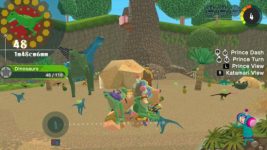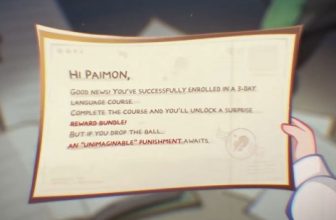
Once Upon a Katamari review
Verdict
![]()
Once Upon a Katamari is a triumphant return for the beloved series, building on everything that makes Katamari Damacy great and making it accessible to a new audience at the same time
When Bandai Namco announced Once Upon a Katamari during a Nintendo Direct in July, I jumped out of my seat with excitement. I didn’t grow up with the world of Katamari Damacy, but after reviewing We Love Katamari Reroll for the Switch and recently replaying it to completion on PC, I can safely say that I’m a fan for life.
Once Upon a Katamari is the first new mainline game for the series in 14 years, following two successful remasters and a push to break away from platform exclusivity. If the aim of this game was to expand on the existing series with new features while also providing lifelong fans with a sense of familiarity, Bandai Namco and RENGAME achieved their goal with flying colors. Before getting into the nitty-gritty details, from the very top level, I can say that if you already love Katamari Damacy, you’ll enjoy this game.
The Prince’s adventure here follows a slightly more linear trajectory than in previous games. Once Upon a Katamari begins with the King of All Cosmos doing some spring cleaning, finding a long-lost scroll, and immediately dropping it on the Earth, destroying it completely. As the Prince, or one of his many cousins, you must travel through Earth’s history and roll things up to fix it. It’s a simple tale, but the comedic writing makes up for the lack of narrative depth. In a game this wacky, we’re not really here for the story anyway.
However, because the plot revolves around us travelling to different eras across human history, it doesn’t all take place on one map like We Love Katamari does. As a result, at certain points, the King pops in and forces you to go to a specific level or new era, making it feel a little more on-rails than previous entries in the series. It’s not a huge drawback, especially as seeing which era comes next is always exciting, but it’s definitely something to note.

Once Upon a Katamari’s core gameplay is as chaotic as ever, and I say that with all the love in the world. Every level is full of items, silly NPCs, and secrets to discover, and it’s a feast for the eyes. If you like collect-a-thons, you’re in for a treat, as there are 68 cousins to find, plus three crowns in every level and a bunch of presents for customization (more on that later).
The new power-up items are a welcome addition to the gameplay loop, each serving its own unique purpose. My personal favorite is the sonar, which points out all of the level’s collectibles for a set duration. Since collecting crowns is crucial to unlocking later stages, it’s great to know where they are so I can secure them early on. The letter grade system for each level also feels kinder than the previous entries’ pass or fail system, even though the King still gets mad at me if I only pass with a D.
One of the reasons I like this more lenient system is that playing Once Upon a Katamari on the Switch is difficult. I encountered similar problems during my We Love Katamari review and thought it was just a skill issue, but after replaying the game with a DualShock 4 controller and then returning to the Switch for this entry, I can safely say that Nintendo’s offset joystick design is not conducive to efficient Katamari rolling. Some of you might find it easier to adjust to than I did, but it could be worth looking at your Nintendo Switch controller collection to see which ones better suit the gameplay.

However, Bandai Namco is clearly aware that this will likely be many people’s first-ever Katamari game, so there is the option to use a single joystick control scheme. This simplifies the gameplay significantly and is much more beginner-friendly – I’ve even seen other reviewers note that it’s great for their young children who struggle to control two joysticks at once. As someone who’s now used to the dual-stick control scheme, the simplified settings didn’t help me much, but I appreciate their addition.
This entry to the series also introduces a new mode called KatamariBall. When I spoke to the game’s producer, Ryo Ishida, in my Once Upon a Katari interview, he described KatamariBall as an “engaging and dynamic multiplayer experience,” and I’d have to agree. There’s certainly a rush to competitive Katamari-ing, and while I often find myself forgetting to deposit my points, instead focusing on making the biggest Katamari and squishing my opponents, it’s a great, fast alternative to the main levels. Plus, it’s a great way to show off your custom cousin design.
I love a bit of character customization in any game, and even though I love playing as specific cousins in Katamari games like L’Amour, Ichigo, and Dipp, I was excited by the prospect of creating my own. When I got into the cousin customization menu, I was genuinely blown away by how detailed it is. Not only can you use the body shape and facial expression of any unlocked cousin, but you can edit their color schemes in intense detail. I’ve already spent more time in that menu than I’d care to admit, and I can see myself making my friends and my original characters as cousins in my spare time.

One of the things about Once Upon a Katamari’s announcement that both scared and excited me was the addition of new songs. Katamari Damacy and We Love Katamari have some of the best videogame soundtracks ever written, in my opinion, so matching that was going to be a challenge. Or so I thought. The composers once again smashed it out of the park and wrote a banging soundtrack that I will be listening to for months to come.
All in all, Once Upon a Katamari is a fantastic return to form for the series. It’s a great introduction for new players, while providing all the things that existing fans love about the games. My only real gripe is the difficulty on the Nintendo Switch, but if you’re a better gamer than me, you might not struggle. For just $40 for the standard edition, it’s more than worth your money.
Once Upon a Katamari is just one of the many new Switch games to come out this year, and earlier this year, Bandai Namco also released a new mobile game in the series on Apple Arcade.






